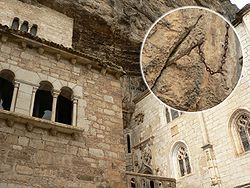Avi
Jedi Council Member
Greetings,
has anyone visited any of the "black Madonna's" scattered throughout the world? I have visited one and am interested in the "appearance" as such, for the local custom/rumour is that this La Moreneta is made of a substance, which at the time, was unlike anything seen or found in the region before. The story goes that a farm-boy found the statue hidden deep in a cave. This is the local tale and I am searching for any online corroborative statements.
If you get a chance to visit Spain, the Monastery at Montserrat is quite breathtaking. This is the place that houses the "original" black madonna I refer to. I use inverted comma's deliberately.
At Montserrat, the mountain appears "alive" with energy and distinct traits appear on the mountain face - particularly at night. I have a personal theory that many a "monk" - if you want to call them that - spent time gazing into the rock face and actually affected or "carved" the energy lines upon the mountain with their meditative states. Again, personal theory, nothing corroborative other than my own experience and realizations there. This place is filled with special energy and has huge expansive vistas.
But back to the Black Madonna, some links/articles on the subject, albeit they are closely related, i.e. not representing any "counter-point"
http://en.wikipedia.org/wiki/Virgin_of_Montserrat
http://campus.udayton.edu/mary//meditations/olmont.html
http://campus.udayton.edu/mary/meditations/blackmdn.html
http://en.wikipedia.org/wiki/Black_Madonna
http://www.thesacredfeminine.com/blackmadonna.html
As a side note, Goethe and Schiller are said to have placed in Montserrat the Holy Grail. (reading more about this claim, seeking original text) I have not researched artifacts much, but am interested in their meaning, and felt it worthwhile to share this here to see of any interest or corroboration/denial.
Cheers,
Avi
has anyone visited any of the "black Madonna's" scattered throughout the world? I have visited one and am interested in the "appearance" as such, for the local custom/rumour is that this La Moreneta is made of a substance, which at the time, was unlike anything seen or found in the region before. The story goes that a farm-boy found the statue hidden deep in a cave. This is the local tale and I am searching for any online corroborative statements.
If you get a chance to visit Spain, the Monastery at Montserrat is quite breathtaking. This is the place that houses the "original" black madonna I refer to. I use inverted comma's deliberately.
At Montserrat, the mountain appears "alive" with energy and distinct traits appear on the mountain face - particularly at night. I have a personal theory that many a "monk" - if you want to call them that - spent time gazing into the rock face and actually affected or "carved" the energy lines upon the mountain with their meditative states. Again, personal theory, nothing corroborative other than my own experience and realizations there. This place is filled with special energy and has huge expansive vistas.
But back to the Black Madonna, some links/articles on the subject, albeit they are closely related, i.e. not representing any "counter-point"
http://en.wikipedia.org/wiki/Virgin_of_Montserrat
http://campus.udayton.edu/mary//meditations/olmont.html
http://campus.udayton.edu/mary/meditations/blackmdn.html
http://en.wikipedia.org/wiki/Black_Madonna
http://www.thesacredfeminine.com/blackmadonna.html
As a side note, Goethe and Schiller are said to have placed in Montserrat the Holy Grail. (reading more about this claim, seeking original text) I have not researched artifacts much, but am interested in their meaning, and felt it worthwhile to share this here to see of any interest or corroboration/denial.
Cheers,
Avi




